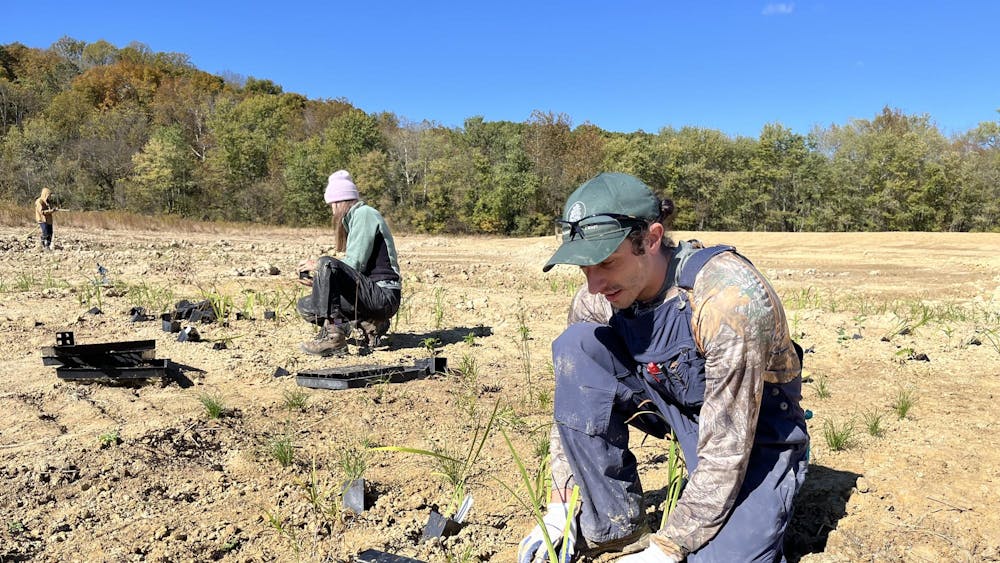Vickie Davison was driving down a rural Bloomington road when it happened. The water started pouring into her truck. She said she knew she and her stepson had to get out.
Davison said she was driving out in the country in the pitch dark in the mid-2000s. She and her stepson climbed out of the back window of her truck to safety.
Davison, the owner of Bloomington Hardware who experienced the flood of 2008, said there are many ways people can prepare for floods.
A flood watch is currently in effect for much of central and southern Indiana.
On Monday afternoon, the Bloomington area experienced rain, but not nearly as much as predicted by the National Weather Service for this evening.
A flood watch is in effect from tonight through Wednesday morning for many central and southern Indiana counties, including Monroe County, according to a report by the NWS.
Joe Skowronek, meteorologist for the Indianapolis office of the NWS, said the watch is in effect from 7 p.m. today to 11 a.m. Wednesday.
“A watch means the potential exists for flooding,” Skowronek said. “It’s not a certainty, but the conditions are favorable for flooding.”
The Bloomington area has had its share of past floods with notable floods in 1913, 1937 and 2008, according to the Indiana Geological Survey.
The Great Flood of 1913 occurred along rivers including the Ohio and Wabash. Nearly every town in Indiana located along a major drainage experienced flooding in 1913, according to the survey. The storm resulted in a total of $25 million of damage. In January 1937, a major flood occurred on the Ohio River Valley.
Severe winter storms in the Midwest lead to intense flood damage across southern Indiana, according to the survey.
A flood in June 2008 resulted in people covered knee-deep in water on Kirkwood Avenue and power out in various buildings on IU’s campus, according to an Indiana Daily Student article from June 5, 2008.
Davison said she remembers the flood of 2008, and she said it was horrible.
“The creek in front of the hardware store was at the bottom of the bridge,” she said. “That bridge is eight feet above you. If I walked underneath, it was raging.”
Immediately following the June 2008 storms, 82 of Indiana’s 92 counties were declared presidential disaster areas, according to the survey.
Davison said one of the main ways to prepare for a storm is to make sure gutters are clean.
“Make sure where the downspout comes out of the yard,” Davison said. “If the gutters in the downspouts are doing their job, they are going to collect the water in the roof and move it away from the house.”
When storm drains are clogged with sticks and ice, water can back up, which can cause increased flooding.
“If you end up seeing a drain that’s full of leaves and trash, make sure that it’s cleaned,” Davison said. “Clean it out and put it in a new trash can.”
Davison said tube sand especially sells during the times when a flood is expected.
“The tube sand is great to put up and stop water from coming into a window well or basement,” she said. “The tube sand makes a nice little barricade against the water.”
Davison said people need to have a basic knowledge of plumbing in the event of water entering their basement. She said many houses have pumps in the event of a flood.
“The pit will collect the water and the pump helps it out, so it will go into the water pipes and sewage pipes,” she said.
Davison said residents should make sure pumps are in working order.
A water alarm is one of the new tools sold at Bloomington Hardware that helps flood prevention, Davison said.
“You put it on the floor near, say, a floor drain,” she said. “As soon as it makes contact with any water, the alarm goes off.”
Davison said the alarm is a really good precaution, especially for people who have experienced flooded basements.
“If you don’t hear an alarm, you could have a real flood down there before you realize it,” she said. “If it’s something you’re aware of quickly, you can get right on it and get a replacement pump to minimize the damage.”
Davison said the main thing is to move things off the ground in case, if someone lives on a ground level without a basement.
“Once the water recedes, get your water extraction equipment in there,” Davison said.
Davison said maintenance and prevention is important, especially for college students.
“I think a lot of times, college students haven’t had to do the maintenance on a house before,” she said.
Davison said people should do a good visual inspection of the house to make sure water is connected and the downspout will take it away from the house.
Companies such as the American Automobile Association offer members 24-hour road service for disabled vehicles.
Greg Seiter, public affairs manager for AAA’s Hoosier Motor Club, said AAA trucks are available to assist members unless an area is declared a state of emergency.
Seiter said Hoosier Motor Club is fully staffed with trucks, because winter is generally a very busy time. Seiter also said what motorists can do in the event of a flood.
“Certainly if water is entering the vehicle, you need to get out as quickly as you possibly can,” Seiter said. “Of course you need to take into consideration whether that means breaking the window, exiting through a door, that means you have to get yourself out.”
Davison said Bloomington Hardware offers glass cutters, which motorists can use if they need to escape the water.
“We sell a lot of glass break,” she said. “It has glass break on one end, so that way you can cut the seat belt, and if you needed to, you can break the glass.”
Skowronek said the best chance of any flooding is during the watch, because heavy rain is expected at those times.
According to a report by the NWS, up to three inches of rain are expected tonight, and flooding is possible in lowland areas.
Skowronek said there is potential to upgrade to a flood warning.
“The potential is there for things to flood, so we may have to upgrade to warnings at that time,” he said. “Everything we are looking at is pointing in that direction at this time.”
Skowronek said people should continue to monitor the forecast and state of weather, especially in areas prone to flooding, such as low-lying areas and areas near rivers.
“When an actual warning is issued, that’s when you want to take action,” he said.
Bloomington issued flood watch

Get stories like this in your inbox
Subscribe





